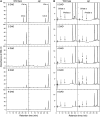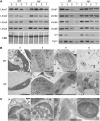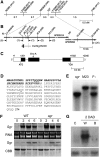The senescence-induced staygreen protein regulates chlorophyll degradation
- PMID: 17513504
- PMCID: PMC1913741
- DOI: 10.1105/tpc.106.044891
The senescence-induced staygreen protein regulates chlorophyll degradation
Abstract
Loss of green color in leaves results from chlorophyll (Chl) degradation in chloroplasts, but little is known about how Chl catabolism is regulated throughout leaf development. Using the staygreen (sgr) mutant in rice (Oryza sativa), which maintains greenness during leaf senescence, we identified Sgr, a senescence-associated gene encoding a novel chloroplast protein. Transgenic rice overexpressing Sgr produces yellowish-brown leaves, and Arabidopsis thaliana pheophorbide a oxygenase-impaired mutants exhibiting a stay-green phenotype during dark-induced senescence have reduced expression of Sgr homologs, indicating that Sgr regulates Chl degradation at the transcriptional level. We show that the leaf stay-greenness of the sgr mutant is associated with a failure in the destabilization of the light-harvesting chlorophyll binding protein (LHCP) complexes of the thylakoid membranes, which is a prerequisite event for the degradation of Chls and LHCPs during senescence. Transient overexpression of Sgr in Nicotiana benthamiana and an in vivo pull-down assay show that Sgr interacts with LHCPII, indicating that the Sgr-LHCPII complexes are formed in the thylakoid membranes. Thus, we propose that in senescing leaves, Sgr regulates Chl degradation by inducing LHCPII disassembly through direct interaction, leading to the degradation of Chls and Chl-free LHCPII by catabolic enzymes and proteases, respectively.
Figures








Similar articles
-
Molecular cloning and function analysis of the stay green gene in rice.Plant J. 2007 Oct;52(2):197-209. doi: 10.1111/j.1365-313X.2007.03221.x. Epub 2007 Aug 21. Plant J. 2007. PMID: 17714430
-
The Stay-Green Rice like (SGRL) gene regulates chlorophyll degradation in rice.J Plant Physiol. 2013 Oct 15;170(15):1367-73. doi: 10.1016/j.jplph.2013.05.016. Epub 2013 Jun 28. J Plant Physiol. 2013. PMID: 23816327
-
Arabidopsis STAY-GREEN2 is a negative regulator of chlorophyll degradation during leaf senescence.Mol Plant. 2014 Aug;7(8):1288-1302. doi: 10.1093/mp/ssu045. Epub 2014 Apr 9. Mol Plant. 2014. PMID: 24719469
-
The Divergent Roles of STAYGREEN (SGR) Homologs in Chlorophyll Degradation.Mol Cells. 2015 May;38(5):390-5. doi: 10.14348/molcells.2015.0039. Epub 2015 Apr 24. Mol Cells. 2015. PMID: 25913011 Free PMC article. Review.
-
Stay-green regulates chlorophyll and chlorophyll-binding protein degradation during senescence.Trends Plant Sci. 2009 Mar;14(3):155-62. doi: 10.1016/j.tplants.2009.01.002. Epub 2009 Feb 23. Trends Plant Sci. 2009. PMID: 19237309 Review.
Cited by
-
Characterization and fine mapping of the rice premature senescence mutant ospse1.Theor Appl Genet. 2013 Jul;126(7):1897-907. doi: 10.1007/s00122-013-2104-y. Epub 2013 Apr 27. Theor Appl Genet. 2013. PMID: 23624440
-
Chlorophyll metabolism in pollinated vs. parthenocarpic fig fruits throughout development and ripening.Planta. 2016 Aug;244(2):491-504. doi: 10.1007/s00425-016-2522-6. Epub 2016 Apr 20. Planta. 2016. PMID: 27097639
-
Functional inactivation of OsGCNT induces enhanced disease resistance to Xanthomonas oryzae pv. oryzae in rice.BMC Plant Biol. 2018 Nov 1;18(1):264. doi: 10.1186/s12870-018-1489-9. BMC Plant Biol. 2018. PMID: 30382816 Free PMC article.
-
Chlorophyll breakdown during pepper fruit ripening in the chlorophyll retainer mutation is impaired at the homolog of the senescence-inducible stay-green gene.Theor Appl Genet. 2008 Jul;117(2):235-40. doi: 10.1007/s00122-008-0768-5. Epub 2008 Apr 22. Theor Appl Genet. 2008. PMID: 18427769
-
Participation of chlorophyll b reductase in the initial step of the degradation of light-harvesting chlorophyll a/b-protein complexes in Arabidopsis.J Biol Chem. 2009 Jun 26;284(26):17449-56. doi: 10.1074/jbc.M109.008912. Epub 2009 Apr 29. J Biol Chem. 2009. PMID: 19403948 Free PMC article.
References
-
- Akhtar, M.S., Goldschmidt, E., John, I., Rodoni, S., Matile, P., and Grierson, D. (1999). Altered patterns of senescence and ripening in gf, a stay-green mutant of tomato (Lycopersicon esculentum Mill.). J. Exp. Bot. 50 1115–1122.
-
- Armstead, I., et al. (2006). From crop to model to crop: Identifying the genetic basis of the staygreen mutation in the Lolium/Festuca forage and amenity grasses. New Phytol. 172 592–597. - PubMed
-
- Armstead, I., et al. (2007). Cross-species identification of Mendel's I locus. Science 315 73. - PubMed
Publication types
MeSH terms
Substances
Associated data
- Actions
- Actions
- Actions
- Actions
- Actions
- Actions
- Actions
- Actions
- Actions
- Actions
- Actions
LinkOut - more resources
Full Text Sources
Other Literature Sources
Molecular Biology Databases

